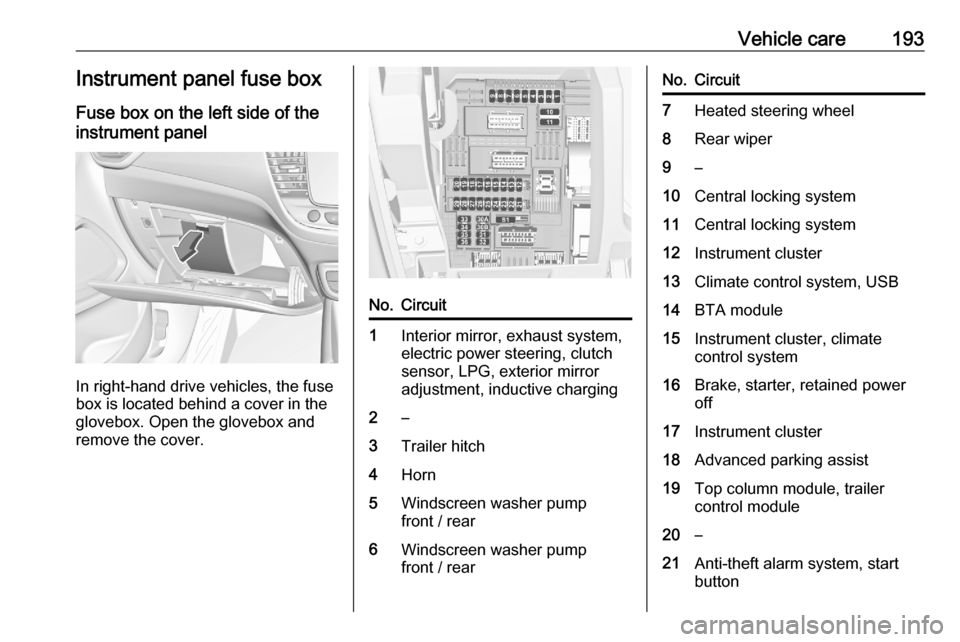brake sensor VAUXHALL CROSSLAND X 2020 Owner's Manual
[x] Cancel search | Manufacturer: VAUXHALL, Model Year: 2020, Model line: CROSSLAND X, Model: VAUXHALL CROSSLAND X 2020Pages: 245, PDF Size: 21.85 MB
Page 13 of 245

In brief111Power windows .....................36
2 Exterior mirrors .....................33
3 Cruise control .....................140
Speed limiter ....................... 143
Heated steering wheel .........70
4 Turn lights ........................... 105
Headlight flash ....................103
High beam ........................... 102
High beam assist ...............102
Exit lighting ......................... 108
Parking lights ...................... 106
Buttons for Driver
Information Centre ................89
5 Side air vents ...................... 119
6 Instruments .......................... 79
Driver Information Centre ...... 89
7 Infotainment controls ...........70
8 Windscreen wiper and
washer, rear wiper and
washer ................................. 71
9 Head-up display ....................93
10 Air vents ............................. 11911Hazard warning flashers ....104
12 Info Display .......................... 91
13 Air vent ................................ 119
14 Light sensor ........................ 102
Rain sensor ........................... 71
Sun sensor .......................... 114
15 Central locking system ..........23
16 Glovebox .............................. 61
Fuse box ............................ 193
17 Controls for Info Display
operation ............................... 91
18 Climate control system ........ 110
19 USB port .............................. 74
20 Electronic Stability Control
and Traction Control ...........139
Lane departure warning .....163
Stop-start system ................126
Parking assist ..................... 150
Advanced parking assist ....153
Electric child locks ................ 28
21 Power outlet .......................... 74
22 Selector lever ...................... 133
23 Parking brake ......................13824Power button ....................... 123
25 Ignition switch .....................123
26 Steering wheel adjustment ..70
27 Horn ..................................... 71
28 Bonnet release lever ..........176
29 Storage ................................. 61
Fuse box ............................ 193
30 Head-up display ....................93
31 Light switch ........................ 101
Headlight range
adjustment ......................... 103
Front fog lights ...................105
Rear fog light ...................... 106
Instrument illumination .......107
Page 70 of 245

68Storage● Do not place any objects on theload compartment cover or theinstrument panel, and do notcover the sensor on top of the
instrument panel.
● The load must not obstruct the operation of the pedals, parking
brake and gear selector, or
hinder the freedom of movement
of the driver. Do not place any
unsecured objects in the interior.
● Do not drive with an open load compartment.9Warning
Always make sure that the load in
the vehicle is securely stowed.
Otherwise objects can be thrown
around inside the vehicle and
cause personal injury or damage
to the load or car.
● The payload is the difference between the permitted gross
vehicle weight (see identification
plate 3 221) and the EC kerb
weight, refer to the EEC
Certificate of Conformity
provided with your vehicle or
other national registration
documents.
To calculate the payload, enter the data for your vehicle in the
weights table at the front of this
manual.
The EC kerb weight includes
weights for the driver (68 kg),
luggage (7 kg) and all fluids (fuel
tank 90% full).
Optional equipment and
accessories increase the kerb
weight.
● Driving with a roof load increases
the sensitivity of the vehicle to
cross-winds and has a
detrimental effect on vehicle
handling due to the vehicle's
higher centre of gravity.
Distribute the load evenly and
secure it properly with retaining
straps. Adjust the tyre pressure
and vehicle speed according to
the load conditions. Check and
retighten the straps frequently.
Do not drive faster than 75 mph.
The permissible roof load is
60 kg. The roof load is thecombined weight of the roof rack and the load.
Page 71 of 245

Instruments and controls69Instruments and
controlsControls ....................................... 70
Steering wheel adjustment ........70
Steering wheel controls .............70
Heated steering wheel ...............70
Horn ........................................... 71
Windscreen wiper and washer ..71
Rear window wiper and washer ...................................... 73
Outside temperature ..................73
Clock ......................................... 74
Power outlets ............................. 74
Inductive charging .....................75
Cigarette lighter ......................... 76
Ashtrays .................................... 76
Warning lights, gauges and indi‐ cators ........................................... 77
Instrument cluster ......................77
Speedometer ............................. 79
Odometer .................................. 79
Trip odometer ............................ 79
Tachometer ............................... 80
Fuel gauge ................................ 80
Engine coolant temperature gauge ....................................... 80Engine oil level monitor.............81
Service display .......................... 81
Control indicators ......................82
Turn lights .................................. 82
Seat belt reminder .....................82
Airbag and belt tensioners .........83
Airbag deactivation ....................83
Charging system .......................83
Malfunction indicator light ..........84
Service vehicle soon .................84
Stop engine ............................... 84
System check ............................ 84
Brake and clutch system ...........84
Parking brake ............................ 85
Antilock brake system (ABS) .....85
Gear shifting .............................. 85
Lane departure warning ............85
Electronic Stability Control and Traction Control system ...........85
Electronic Stability Control and Traction Control system off ......86
Engine coolant temperature ......86
Preheating ................................. 86
Exhaust filter .............................. 86
AdBlue ....................................... 86
Deflation detection system ........86
Engine oil pressure ....................87
Low fuel ..................................... 87
Autostop .................................... 87
Exterior light .............................. 87Low beam.................................. 87
High beam ................................. 87
High beam assist .......................88
Front fog lights ........................... 88
Rear fog light ............................. 88
Rain sensor ............................... 88
Cruise control ............................ 88
Side blind spot alert ...................88
Active emergency braking .........88
Speed limiter ............................. 88
Door open .................................. 88
Displays ....................................... 89
Driver Information Centre ..........89
Info Display ................................ 91
Head-up display ........................93
Vehicle messages ........................95
Warning chimes .........................95
Vehicle personalisation ................96
Telematics services .....................99
Vauxhall Connect ......................99
Page 80 of 245

78Instruments and controlsOverviewOTurn lights 3 82XSeat belt reminder 3 82vAirbag and seat belt
tensioners 3 83VAirbag deactivation 3 83pCharging system 3 83ZMalfunction indicator light
3 84CService vehicle soon 3 84STOPStop engine 3 84JSystem check 3 84RBrake and clutch system
3 84mParking brake 3 85uAntilock brake system (ABS)
3 85RGear shifting 3 85)Lane departure warning
3 85bElectronic Stability Control
and Traction Control system
3 85aElectronic Stability Control
and Traction Control system
off 3 86W oEngine coolant temperature
high 3 86!Preheating 3 86%Exhaust filter 3 86YAdBlue 3 86wDeflation detection system
3 86IEngine oil pressure 3 87
Engine oil level monitor
3 81Y oLow fuel 3 87DAutostop 3 878Exterior light 3 879Low beam 3 87CHigh beam 3 87fHigh beam assist 3 88>Front fog lights 3 88øRear fog light 3 88
Page 90 of 245

88Instruments and controlsIlluminated when high beam is on or
during headlight flash 3 102.
High beam assist f illuminates green.
The high beam assist is activated
3 102.
Front fog lights
> illuminates green.
The front fog lights are on 3 105.
Rear fog light
ø illuminates yellow.
The rear fog light is on 3 106.
Rain sensor < illuminates green.
Illuminated when automatic wiping
with rain sensor is activated.
Windscreen wiper and washer 3 71.Cruise control
m illuminates in the Driver
Information Centre.
Cruise control 3 140.
Side blind spot alert
B illuminates green.
The system is active 3 158.
Active emergency braking m illuminates or flashes yellow.
Illuminates
The system has been deactivated or
a fault has been detected.
Additionally, a warning message is
displayed in the Driver Information
Centre.
Check the reason of the deactivation
3 147 and in case of a system fault,
seek the assistance of a workshop.Notice
m also illuminates if the seat belts
of the front passengers are not
fastened. In this case, active
emergency braking is deactivated.
Flashes
The system is actively engaged.
Depending on the situation, the
vehicle may automatically brake
moderately or hard.
Forward collision alert 3 145.
Front pedestrian protection 3 149.
Speed limiter
ß illuminates in the Driver
Information Centre.
Speed limiter 3 143.
Door open h illuminates red.
A door or the tailgate is open.
Page 149 of 245

Driving and operating147In the following cases, forward
collision alert may not detect a vehicle
ahead or sensor performance is
limited:
● driving on winding or hilly roads
● driving in the dark
● weather limits visibility, such as fog, rain, or snow
● the sensor in the windscreen is blocked by snow, ice, slush, mud,dirt etc.
● the windscreen is damaged or affected by foreign objects, e.g.
stickers
Active emergency braking
Active emergency braking can help to reduce the damage and injury from
crashes with vehicles, pedestrians and obstacles directly ahead, when a
collision can no longer be avoided
either by manual braking or by
steering. Before the active
emergency braking applies, the driver is warned by the forward collision
alert or the front pedestrian protection
alert.Forward collision alert 3 145.
Front pedestrian protection 3 149.
The feature uses various inputs (e.g.
camera sensor, brake pressure,
vehicle speed) to calculate the
probability of a frontal collision.9 Warning
This system is not intended to
replace the driver responsibility for driving the vehicle and looking
ahead. Its function is limited to
supplemental use only to reduce
the vehicle speed before a
collision.
The system may not react to
animals. After a sudden lane
change, the system needs a
certain time to detect the next
preceding vehicle.
The driver must always be ready
to take action and apply the brakes and steer to avoid collisions.
Functionality
Active emergency braking is
equipped with a front camera and
operates in forward gear in the range
between walking speed and 53 mph.
The system detects stationary
vehicles only if the speed does not
exceed 50 mph.
A precondition is that forward collision
alert with front camera system is not
deactivated in the vehicle
personalisation menu 3 96.
The system includes: ● emergency automatic braking● forward looking brake assist
● forward collision alert
● front pedestrian protection
Emergency automatic braking
After activation of brake preparation
system and just before the imminent
collision, this function automatically
applies limited braking to reduce the
impact speed of the collision or
prohibit a crash. If active emergency
braking is applied, m flashes in the
instrument cluster. Depending on the
Page 195 of 245

Vehicle care193Instrument panel fuse boxFuse box on the left side of the
instrument panel
In right-hand drive vehicles, the fuse
box is located behind a cover in the
glovebox. Open the glovebox and
remove the cover.
No.Circuit1Interior mirror, exhaust system,
electric power steering, clutch
sensor, LPG, exterior mirror
adjustment, inductive charging2–3Trailer hitch4Horn5Windscreen washer pump
front / rear6Windscreen washer pump
front / rearNo.Circuit7Heated steering wheel8Rear wiper9–10Central locking system11Central locking system12Instrument cluster13Climate control system, USB14BTA module15Instrument cluster, climate
control system16Brake, starter, retained power
off17Instrument cluster18Advanced parking assist19Top column module, trailer
control module20–21Anti-theft alarm system, start
button
Page 236 of 245

234Customer informationVehicle data recording
and privacy
Event data recorders
Electronic control units are installed in
your vehicle. Control units process
data which is received e.g. by vehicle sensors, or which they generate
themselves or exchange amongst
themselves. Some control units are
necessary for the safe functioning of
your vehicle, others assist you while
you drive (driver assistance systems),
while others provide comfort or
infotainment functions.
The following contains general
information about data processing in
the vehicle. You will find additional
information as to which specific data
is uploaded, stored and passed on to third parties and for what purpose in
your vehicle under the key word Data Protection closely linked to the
references for the affected functional
characteristics in the relevant
Owner's Manual or in the general
terms of sale. These are also
available online.Operating data in the vehicle
Control units process data for
operation of the vehicle.
This data may include: ● vehicle status information (e.g. speed, movement delay, lateral
acceleration, wheel rotation rate,
"seat belts fastened" display)
● ambient conditions (e.g. temperature, rain sensor,
distance sensor)
As a rule such data is transient and is
not stored for longer than an
operational cycle, and only processed
on board the vehicle itself. Often
control units include data storage
(including the vehicle key). This is
used to allow information to be
documented temporarily or
permanently on vehicle condition,
component stress, maintenance
requirements and technical events
and errors.Depending on technical equipment
levels, the data stored is as follows:
● system component operating states (e.g. fill level, tyre
pressure, battery status)
● faults and defects in important system components (e.g. lights,
brakes)
● system reactions in special driving situations (e.g. triggeringof an airbag, actuation of the
stability control systems)
● information on events damaging the vehicle
● for electric vehicles the amount of
charge in the high-voltage
battery, estimated range
In special cases (e.g. if the vehicle
has detected a malfunction), it may be
necessary to save data that would
otherwise just be volatile.
When you use services (e.g. repairs,
maintenance), the operating data
saved can be read together with the
vehicle identification number and
used where necessary. Staff working
for the service network ( e.g. garages,
manufacturers) or third parties (e.g.